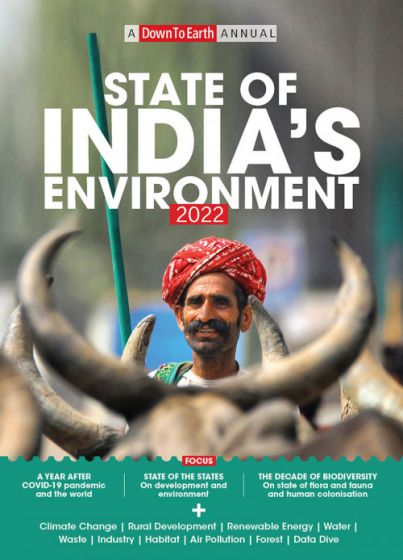Maharashtra, Odisha and Madhya Pradesh have suffered the maximum from extreme weather events in 2021, says IMD chief at CSE’s annual media meet
Mrutyunjay Mohapatra, director general of meteorology, India Meteorological Department (IMD), was speaking at Anil Agarwal Dialogue 2022
For details of AAD 2022 and its presentations and proceedings (streamed live as well as recorded):
The Annual State of India’s Environment 2022 report is available here on sale Click here
New Delhi/Nimli (Rajasthan), March 2, 2022: In 2021, extreme weather events accounted for the maximum number of deaths in the states of Maharashtra, Odisha and Madhya Pradesh; and the largest number of districts were affected in Madhya Pradesh, Maharashtra and Uttar Pradesh. This emerged from a presentation made by Mrutyunjay Mohapatra, director general of meteorology, India Meteorological Department (IMD), at a four-day national conclave of journalists being organised by Centre for Science and Environment (CSE).
Anil Agarwal Dialogue 2022, as the conclave is called, is an annual event. This year, it has brought together about 70 journalists from across the country to discuss some of the key environmental challenges facing India. The Dialogue was inaugurated on March 1 by the Union minister for environment, forest and climate change, Bhupender Yadav, who also released CSE and Down To Earth magazine’s Annual State of India’s Environment 2022 report on the occasion.
Speaking at a session on extreme weather events and climate change at the Dialogue today, Akshit Sangomla, senior reporter, Down To Earth, pointed out: “2021 was a very significant year, a year of extremes. It was one of the seven warmest years ever recorded. India ranked third in the world in experiencing climate change disasters. And lightning and thunderstorms accounted for the maximum number of climate-change related deaths.”
As per the IPCC’s Sixth Assessment Report, the Earth's average surface temperature rise will cross 1.5°C in the next 20 years, and 2°C by the middle of the century, if there is no drastic reduction in GHG emissions. Even if emissions are brought to net-zero by the middle of the 21st century, there will be an “overshoot” of the 1.5°C limit by 0.1°C. The threshold of 2°C will be “exceeded during the 21st century” without deep emissions cuts “in the coming decades”. Says Sangomla: “A scary forecast is that the Arctic is likely to become sea-ice free in September -- the peak summer month -- at least once before 2050.”
A P Dimri, professor of environmental sciences at Delhi’s Jawaharlal Nehru University – who was one of the speakers – echoed the dire warnings. “Glaciers are depleting and increasing the flow of rivers in north India. The northern sides of the country will receive more rain compared to the eastern side. Cloudburst is becoming common, and we have found that in case of a cloudburst along the foothills of the Himalayas, the precipitation goes up by 14 per cent.”
Roxy Mathew Koll, climate scientist with the Indian Institute of Tropical Meteorology in Pune, speaking in the same session, focused on the relatively lesser known phenomenon of marine heatwaves. According to him, the Indian Ocean is the fastest warming ocean basin in the world, and this will have serious impacts on the South Asian region. Marine heatwaves are leading to a decline in phytoplankton populations, and affecting the ocean fisheries.
“About 93 per cent of the heat from global warming goes into the oceans. Warm waters are an energy source for cyclones – the frequency, intensity, rapidity and duration increases with rising temperatures. The Indian Ocean, our research shows, will become conducive to cyclones as warming rises. Marine heatwaves also lead to marine habitat destruction due to coral bleaching, seagrass destruction and loss of kelp forests, affecting the fisheries sector adversely,” said Mathew Koll.
Speaking before the session, Sunita Narain, director general, CSE had rung the alarm bells: “The latest IPCC report has made it clear that the world has a small window to act to reverse the damage -- climate change impacts are devastating; half the world’s population is highly vulnerable to the catastrophic changes; and this will get worse, much worse. The report acknowledges that the poor in the world are the worst hit – they are the victims, they have not contributed to the stock of greenhouse gases in the atmosphere. And the report – for the first time – has talked about increasing climate change-related displacement. This will increase insecurity in our world.”
प्रेस विज्ञप्ति
सीएसई की स्टेट ऑफ इंडियाज एनवायरमेंट 2022 रिपोर्ट के मुताबिक, भारत सरकार कम से कम उन 17 प्रमुख लक्ष्यों को पाने में चूक सकती है, जिनकी समय सीमा इस साल के अंत तक है
For more details, contact Sukanya Nair, The CSE Media Resource Centre, sukanya.nair@cseindia.org / +91-8816818864


Share this article